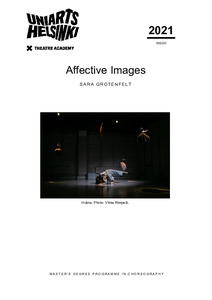Affective images
Grotenfelt, Sara (2022)
Grotenfelt, Sara
Taideyliopiston Teatterikorkeakoulu
2022
Maisterin opinnäytetyö
koreografia
Julkaisun pysyvä osoite on
https://urn.fi/URN:NBN:fi-fe2022050633377
https://urn.fi/URN:NBN:fi-fe2022050633377
Tiivistelmä
In this written part of my master thesis I approach the making of choreography through what I call affective images. I use the artistic part of my thesis, Huldra, as an example of how I have worked with affective images and how I wish to work with them in the future. Both the structure and the content of this thesis fluctuate between the inside and the outside of the artistic work, inspired by the image of the Möbius strip as presented by philosopher Elizabeth Grosz. As theoretical discussion partners I use e.g. philosopher Brian Massumi’s writings to contextualize my use of the word ‘affect’ and writings by painter Tarja Pitkänen-Walter, film critic Laura U. Marks and performance researcher Ric Allsopp to contextualize my use of the word ‘image’.
In chapter 1, I go through the process of making Huldra and lay out a base for the reflection further on. At the end of the first chapter I introduce the idea of the Möbius strip and explain how I use it for describing the interactions between making and writing as well the flow of affects in choreography.
In chapter 2, I elaborate on what I mean with the concept of affective images in dialogue with theory and suggest how it can be dealt with in the practice of choreography
In the third chapter, I describe three scenes from Huldra in detail, painting affective images from the piece for the reader through text. I will elaborate on what constitutes affective images in those scenes and I will propose a seed of a method for how to work with affective images in the future.
In the final chapter, I will speculate upon the possibility of making Huldra again and the choices I would take after having written this thesis and thoroughly reflected on my artistic interests. Tässä maisterintutkinnon opinnäytteen kirjallisessa osiossa lähestyn koreografian tekemistä affektiivisten kuvien kautta. Taiteellinen opinnäytteeni Huldra toimii käytännön esimerkkinä työskentelystäni ja peilaan sitä vasten ajatuksiani affektiivisista kuvista. Sekä tämän kirjallisen osion muoto että sen sisältö ovat saaneet innoitusta filosofi Elizabeth Groszin Möbiuksen nauhan metaforasta. Ajatukseni aaltoilevat taiteellisen työskentelyn sisä- ja ulkopinnoilla. Teoreettisina keskustelukumppaneina toimivat mm. filosofi Brian Massumin kirjoitukset, jotka kontekstualisoivat ajatuksiani affektista, ja taitelijia Tarja Pitkänen-Walterin, elokuvakriitikko Laura U. Marksin ja esitysteoreetikko Ric Allsoppin kirjoitukset, jotka kontekstualisoivat ajatuksiani kuvista.
Ensimmäisessä luvussa käyn läpi Huldran tekoprosessia ja luon pohjan tekstin myöhemmälle reflektiolle. Luvun loppupuolella esittelen Elizabeth Groszin idean Möbiuksen nauhasta ja selitän, miten käytän tätä metaforaa kuvatakseni taiteellisen työn ja siitä kirjoittamisen suhdetta, sekä affektien virtaamista koreografiassa.
Toisessa luvussa kuvailen, mitä tarkoitan affektiivisilla kuvilla ja kuinka ne toimivat koreografisessa praktiikassani, keskustellen teoreettisten lähteiden kanssa.
Kolmannessa luvussa kuvailen kolmea Huldran kohtausta yksityiskohtaisesti, piirtäen affektiivisia kuvia lukijalle tekstin keinoin. Pohdin, miten affektiiviset kuvat syntyvät näissä kohtauksissa ja ehdotan metodin siementä työskentelylle affektiivisten kuvien parissa tulevaisuudessa.
Viimeisessä luvussa leikittelen mahdollisuudella tehdä Huldra uudestaan ja pohdin, millaisia valintoja tekisin nyt, kirjoitettuani tämän opinnäytteen ja pohdittuani taiteellisia kiinnostuksenkohteitani perusteellisesti
In chapter 1, I go through the process of making Huldra and lay out a base for the reflection further on. At the end of the first chapter I introduce the idea of the Möbius strip and explain how I use it for describing the interactions between making and writing as well the flow of affects in choreography.
In chapter 2, I elaborate on what I mean with the concept of affective images in dialogue with theory and suggest how it can be dealt with in the practice of choreography
In the third chapter, I describe three scenes from Huldra in detail, painting affective images from the piece for the reader through text. I will elaborate on what constitutes affective images in those scenes and I will propose a seed of a method for how to work with affective images in the future.
In the final chapter, I will speculate upon the possibility of making Huldra again and the choices I would take after having written this thesis and thoroughly reflected on my artistic interests.
Ensimmäisessä luvussa käyn läpi Huldran tekoprosessia ja luon pohjan tekstin myöhemmälle reflektiolle. Luvun loppupuolella esittelen Elizabeth Groszin idean Möbiuksen nauhasta ja selitän, miten käytän tätä metaforaa kuvatakseni taiteellisen työn ja siitä kirjoittamisen suhdetta, sekä affektien virtaamista koreografiassa.
Toisessa luvussa kuvailen, mitä tarkoitan affektiivisilla kuvilla ja kuinka ne toimivat koreografisessa praktiikassani, keskustellen teoreettisten lähteiden kanssa.
Kolmannessa luvussa kuvailen kolmea Huldran kohtausta yksityiskohtaisesti, piirtäen affektiivisia kuvia lukijalle tekstin keinoin. Pohdin, miten affektiiviset kuvat syntyvät näissä kohtauksissa ja ehdotan metodin siementä työskentelylle affektiivisten kuvien parissa tulevaisuudessa.
Viimeisessä luvussa leikittelen mahdollisuudella tehdä Huldra uudestaan ja pohdin, millaisia valintoja tekisin nyt, kirjoitettuani tämän opinnäytteen ja pohdittuani taiteellisia kiinnostuksenkohteitani perusteellisesti
Kokoelmat
- Kirjalliset opinnäytteet [1402]
